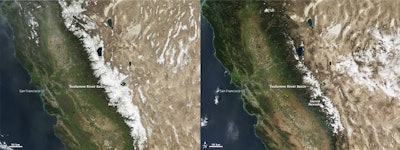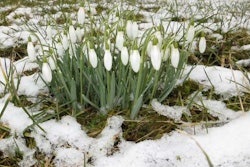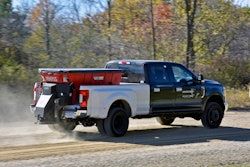 This comparison of the Sierra Nevada snowpack from March 27, 2010 (left) to March 29, 2015 (right) shows just how much the snowpack has diminished during the drought.
This comparison of the Sierra Nevada snowpack from March 27, 2010 (left) to March 29, 2015 (right) shows just how much the snowpack has diminished during the drought.Photo: earthobservatory.nasa.gov
The California Department of Water Resources conducted its first measurements of the year for the Sierra Nevada snowpack last week and the numbers looked promising.
The overall reading for the Sierra right now is 108 percent of average. While this is encouraging, Frank Gehrke, chief of the California cooperative snow surveys program, says that the true results will not be known until April or May.
“The critical thing is going to be for a real solid (snow) production in terms of the rest of the season and on into May,” Gehrke told The Sacramento Bee. “We’re encouraged, but we’ve got a good four to five months before the final tale is told.”
Gehrke is understandably cautious about becoming too optimistic this early in the season. Last year the snowpack was 50 percent of average in December, but by April it was at 5 percent. While forecasts for El Nino currently predict heavy rains, snow is less certain.
“There’s hope, I think, so much more so than we had last year,” Gehrke told the newspaper. “El Nino is not a slam dunk; it doesn’t guarantee you anything.”
While rainwater is needed, mountain snow accounts for 30 percent of the state’s water supply in a year. According to state hydrologist Maury Roos, the 154 major reservoirs currently hold 11.9 million acre-feet. The total capacity for the reservoirs is 38 million acre-feet.
However, one wet winter and spring has been known to bring drought to an end. Roos stated that in 1978 it ended a two-year drought and in 1993 it concluded a six-year drought.
Several different factors will influence how confident state officials become that California will have enough water for the hotter months.
A spokesman for the Department of Water Resources, Ted Thomas, says reservoir storage would need to reach 90 percent of average levels, the runoff forecasts would need to be 110 percent of average, or reservoirs in the Sacramento River basin would need to reach flood-control stage for the drought to be considered over.
As the drought’s hoped-for demise remains uncertain, Californians are still being asked to conserve water in any way they can, and state officials are considering whether to extend Gov. Jerry Brown’s executive order mandating water conservation to the end of October.
“After four bone-dry years, we have a lot of catch-up to do, and it’s not likely to happen in one winter,” said Terry Erlewine, general manager of the State Water Contractors, the state’s largest association of water agencies.











